Mr. Bear may currently be in hiding, but he can scarcely contain himself. The media is currently focused on the financial garbage from Greece and Puerto Rico stinking up investment portfolios, but truth be told, the entire global bond market is putrid. Then there’s the hundreds of trillions of dollars of OTC interest-rate derivatives purchased from Wall Street by rubes in the money-management and hedge-fund industries to hedge their credit risks.
Graham Summers of Phoenix Capital Research made this point on the Greek debt issue:
“As I write this, the markets are moving higher on news that Greek PM Tsipras is willing to accept the bailout offer that the IMF made before the default. The markets are misreading this. That bailout offer has expired; even if the IMF allows such a deal, the damage has been done. At the end of the day, the “Greek” issue is in fact a “debt” issue. And Greece is just a drop in the ocean of debt sloshing around the financial system.”
Mr. Summers’ point was that many billions of dollars of Credit Default Swaps bundled with the $1.5 billion dollar Greek IMF debt are now in the money, or should be. But no one in the financial media seems to be aware of the dire implications. What happens to the banks who are counterparties to these credit default swaps when bond holders demand specific performance on these derivative contracts two seconds after the Greek default? Since the bonds in default are owned by the IMF, and the IMF won’t recognize government defaults, they classified the Greek default as being in a “state of arrears.”
This is clearly a dodge to protect the banks from their impossible legal obligations, obligations they knew were impossible from day one when they willingly assumed them – for fees and commissions. Never in the history of finance has there been such a premium placed on insincere government regulation and banking integrity.
It’s obvious what the “policy makers” are trying to do; exactly what they’ve been doing since the late 1980s; keep the game going at all costs. Sadly though, the costs incurred in this farcical experiment in unconstrained debt creation have expanded to the point of being catastrophic.
To better understand this mess, let’s examine two key interest rates used by the “policy makers” to stimulate or brake what they call “economic growth”:
The Fed Funds Rate (overnight money)
Yield on the US Treasury Long Bond
The Federal Reserve sets the Fed Funds Rate to stimulate or restrain “economic growth.” This is called “monetary policy.” The yield on the US Treasury long bond is set by supply and demand factors in the Treasury bond market, or used to be before Doctor Bernanke instituted “Operation Twist” in September 2011. The chart below examines six decades of bond market reaction (Red Plot) to Washington’s inflationary monetary policy, and the Federal Reserve’s FOMC response to changes in the bond market (Blue Plot).
Since 1954, there have been two distinct eras in the market; the first from 1954 to 1981, during which Treasury long-bond yields experienced a horrifying increase from 2% to 15% in response to growing consumer price inflation. The Federal Reserve’s response (beginning in the 1960’s) was to invert the yield curve by raising the Fed Funds Rate above long-bond yields, resulting in economic recessions and rising unemployment. Once the FOMC concluded that the population had suffered sufficiently, they would lower the Fed Funds Rate below long-bond yields to once again “stimulate” the economy. The FOMC inverted the yield curve four times between 1966 and 1983, with each yield inversion more extreme than the last.
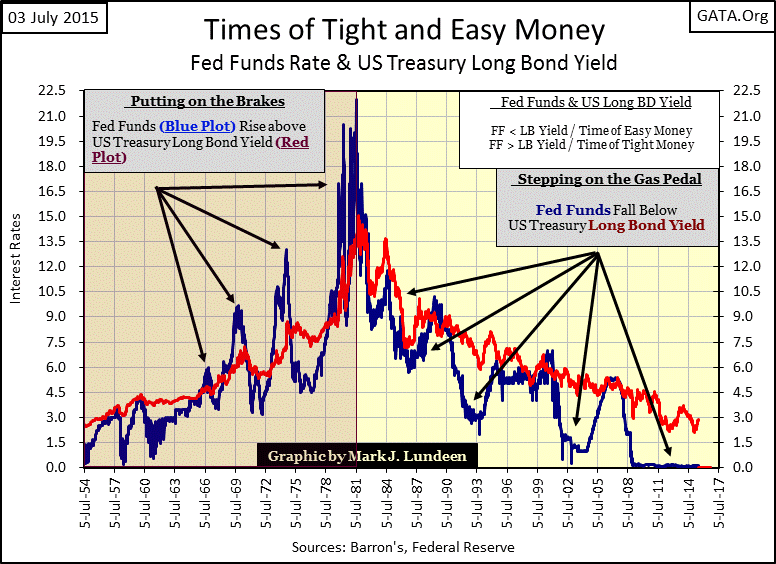
The “policy makers” were playing a dangerous game with the world’s reserve currency. Barron’s magazine documented this brinkmanship in banking and the US dollar. Below I’ve listed just a few of the Barron’s articles on this subject.
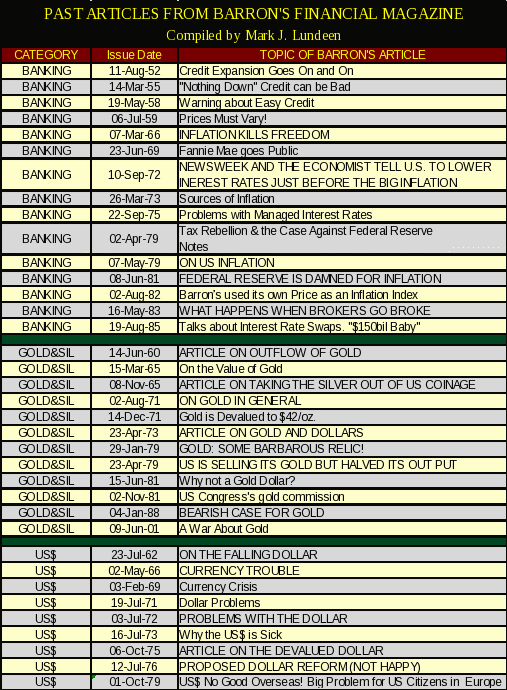
The logical way to interpret the first period in the chart above (1954-1981) is that it shows the market’s natural reaction to being weaned off the sound dollar promised by the Bretton Woods Monetary Agreement of 1945. Look at the last listing on the table above. In 1979, the dollar was suffering from double-digit inflation. In response, Europeans actually refused to accept the US dollar from tourists and businessmen in payment at restaurants and hotels!
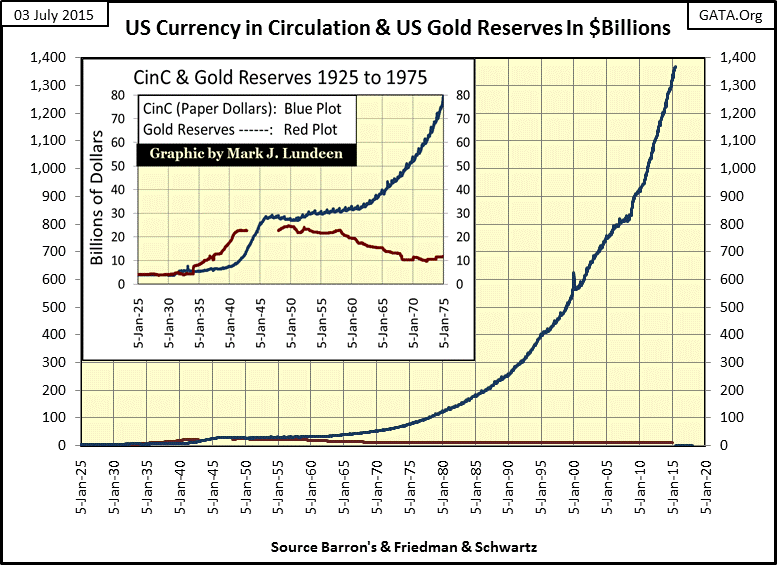
The global economy was fed up with the torrent of paper dollars from the United States, and that is how Paul Volcker became a monetary hero when he jacked the Fed Funds Rate up far above long-bond yields, and kept it there for the better part of four years. Mr. Volcker saved the US dollar.
Bond yields peaked in October 1981, marking the beginning of a bull market in bonds that has continued to this day. With consumer-price inflation contained, the world soon discovered the wonders of purchasing bonds with double digit yields. This initiated the second period seen in the chart above when the world learned to love monetary inflation – just as long as it kept flowing into financial assets. Inflationary rising prices were now called bull markets and “economic growth,” but the price increases were from monetary inflation all the same.
Take a quick look at the first chart above. From 1954 to 1981, the Federal Reserve frequently inverted the yield curve to tame consumer-price inflation as bond yields were continually rising. However, after 1983, as bond yields declined, the FOMC seldom inverted the yield curve, and when it did, the inversion was small and short lived for fear of popping a bubble “monetary policy” had inflated somewhere in the economy. The chart below shows the actual yield spread between the Fed Funds Rate and the US Treasury’s long bond yield plots seen above.
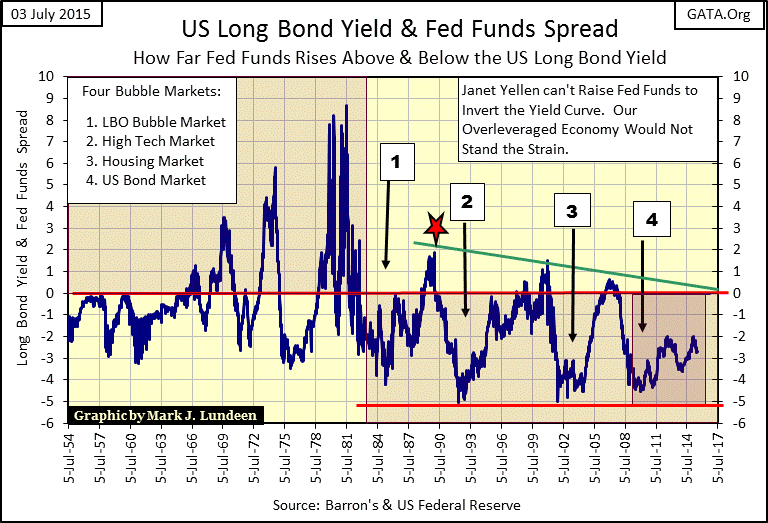
Since 1983, with monetary inflation now flowing into financial asset valuations rather than consumer prices, Greenspan and Bernanke preferred maintaining their celebrity status on CNBC rather than acting responsibly to extinguish the inflationary flame burning in the stock and bond markets.
Below, we see the frequency distribution of the same yield-spread data plotted above. Yield inversions above the 0 row are weeks of “tight money,” when the FOMC had the Fed Funds rate set higher than the US Treasury’s long bond yield in order to induce recessions with rising unemployment. Rows 0 and below are weeks of “loose money” (Fed Funds set below long-term bond yields), which before 1981 resulted in rising consumer prices, but afterwards inflated bubbles in financial assets, including real estate prices.
Between 1954 to December 1982, the FOMC instituted tight money for 454 weeks (30.5% of total weeks), but after 1982, tight money was imposed on the markets for only 172 weeks (10.1% of total weeks). This was a paradigm shift. After 1982, the FOMC never again inverted the yield curve by 2% or more; however, before 1983, the yield curve was inverted more than 2% for a total of 186 weeks, with 59 weeks seeing a yield inversion of 5% or more!
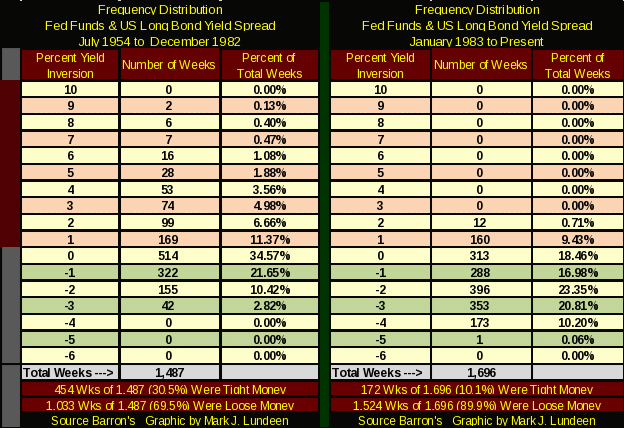
Let’s examine the first post 1983 bubble seen in the charts above: the Leveraged Buyout Bubble (LBO) of the Reagan Administration. Oliver Stone’s 1987 movie “Wall Street” memorialized this era’s nefarious activities, when corporate raiders would buyout publicly traded companies to “restructure” their operations. “Restructuring:” a euphemism for pillaging employees’ pension funds and other liquid assets the targeted company possessed. After “restructuring,” the companies would be less viable than before, but their share prices were greatly enhanced in the process.
The focus of Mr. Stone’s film was on criminal market manipulation, but he missed the real point of the LBO era: where did the Gordon Gekko intend to get the money for his hostile Leveraged Buyout of Blue Star Airlines? He knew he could get it from a merger and acquisition (M&A) department of a major Wall Street bank with an unlimited line-of-credit from the Federal Reserve. And the Federal Reserve never asks Wall Street what they intend to do with the money. Wall Street was clearly a fictional movie plot, as both Gordon Gekko and Bud Fox went to jail. In the real world of Wall Street, no one intimately connected to our system of credit, important people like Jon Corzine of MF Global, ever go to jail for criminal activity in America’s “regulated markets.”
But good times, even on Wall Street, don’t last forever. From December 1989 to January 1990, Alan Greenspan inverted the yield curve to curb the “inflationary excesses” of the LBO bubble period (Red Star in Chart above). Greenspan’s maximum inversion during this year of tight money was only 1.90% above the US Treasury’s Long Bond Yield. During this time, much of Wall Street’s activities were in the Japanese real estate and stock market bubbles of the 1980s, which began deflating in 1989 and causing problems for Wall Street.
Had Alan Greenspan actually been a responsible central banker, he would have inverted the yield curve in excess of 3% and kept it inverted until Wall Street’s reckless bankers (the ones who lent money to people like Gordon Gekko) filed for bankruptcy. No one enjoys bankruptcy, and the pain would have spread far and wide from Wall Street. But Wall Street’s “Masters of the Universe” and retail speculators would have been taught a lesson: that there was a price to pay for recklessness in credit creation, nipping in the bud the waves of inflationary booms and busts that were to follow.
Unfortunately, Greenspan didn’t do the right thing. What he did do is clearly evident in the interest rate charts above; beginning in 1990, he began “stimulating economic growth” by lowering the Fed Funds Rate. By May of 1992, it was down to 3%, a full 5% below the US Treasury’s long bond yield, the most “accommodative monetary policy” since 1954. Wall Street was “re-liquefied” by borrowing money at the Fed for 3%, which they would then lend to the federal government (purchase US Treasury bonds) yielding over 7%. Yep – the taxpayers bailed out Gordon Gekko and his investment banker. This carry trade was a gift to Wall Street and was commented upon by the financial media at the time, earning Alan Greenspan great “street credibility.” This period of easy money was also responsible for inflating the NASDAQ high-tech bubble, #2 bubble in the chart above.
And that’s how we got to where we are today (bubble #4); inflation flowing from the Federal Reserve, and other global central banks was lent to banks far below market rates, who then lent it to speculators and governments, who use the borrowed funds far less efficiently than money lent at market rates. Whether or not the borrowed money (inflation “injected” into the banking system) could be repaid sometimes wasn’t a consideration, as with Detroit, subprime mortgages and now Greece and Puerto Rico. To compensate this flaw in the system, Wall Street bundled risky derivatives with this junk grade sovereign debt to keep yields low, just as they had done with subprime mortgages six years earlier.
Looking back at the chart of the yield spread between the Fed Funds rate and the long bond, you can see Janet Yellen’s current dilemma. Since 1954, no other period of easy money has lasted this long (bubble #4). And if the Fed Funds / bond yield spread has been rising since 2011, it’s not because the Federal Reserve has increased the Fed Funds rate, which has remained near zero percent since late 2008, but because of Operation Twist in 2011, when the Fed under Bernanke began monetizing long bonds with the intent of lowering long term interest rates.
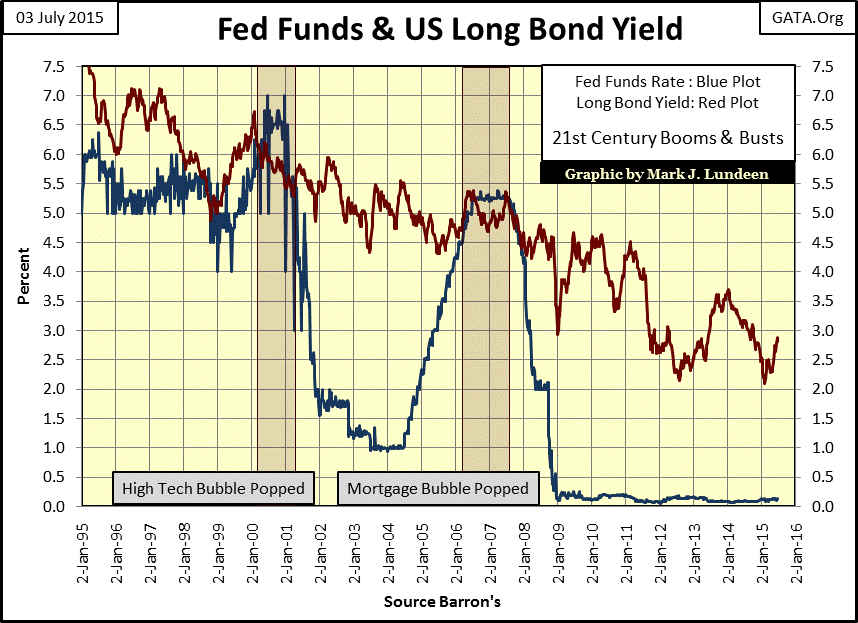
As is painfully clear above, if Yellen increases the Fed Funds rate back to historical norms, or even back to 2006-07 levels, the yield curve would be inverted by more than 2%, which would crash our heavily indebted economy. Don’t be fooled by official comments in the media; the Fed Funds Rate has fallen down and it can’t get up without initiating calamity, no matter what “the experts” say.
But then, should yields on long-term Treasury debt increase to over 6%, “monetary policy” would then become the most accommodative in history, and that may force Yellen to increase the Fed Funds Rate. But before that, I expect to see another bout of Quantitative Easing. Like all dilemmas, Yellen’s offers her no easy options.
